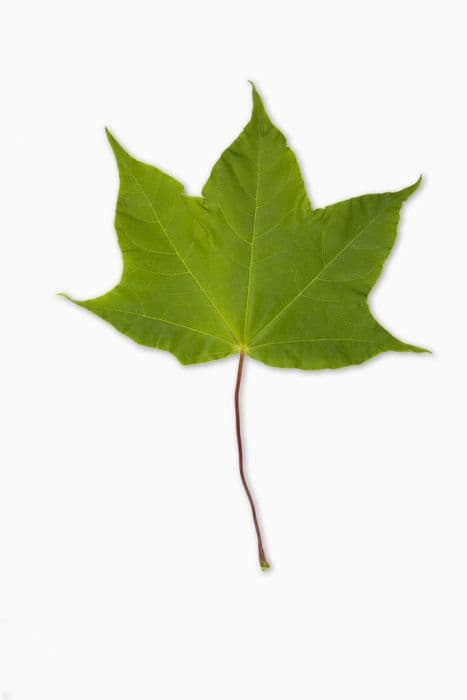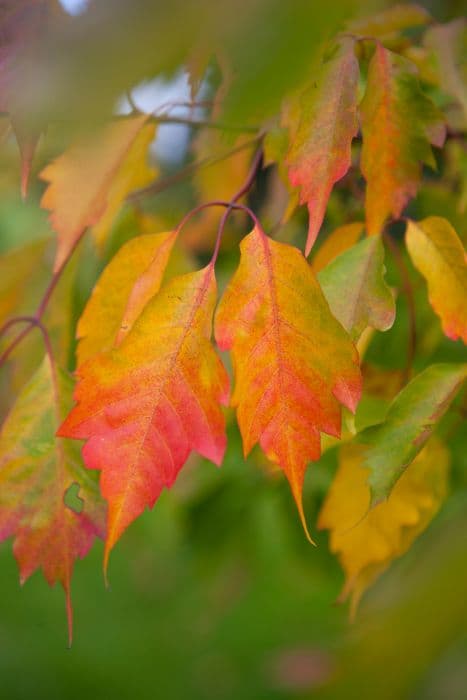Japanese maple 'Trompenburg' Acer palmatum 'Trompenburg' (M)

ABOUT
'Trompenburg' is a deciduous shrub or small tree, the leaves narrowly 7-lobed with recurved margins, deep red-purple in spring, becoming greener in summer, and orange-red in autumn
About this plant
 Names
NamesFamily
Sapindaceae
Synonyms
Trompenburg Japanese Maple, Trompenburg Red Maple
Common names
Acer palmatum 'Trompenburg'.
 Characteristics
CharacteristicsLife cycle
Perennials
Foliage type
Deciduous
Color of leaves
Varies
Height
15 feet (4.57 meters)
Spread
10 feet (3.05 meters)
Plant type
Tree
Hardiness zones
5
Native area
Japan
Benefits
 General Benefits
General Benefits- Ornamental Appeal: Japanese maple 'Trompenburg' has unique foliage with deeply lobed, reddish-purple leaves that add aesthetic value to any landscape.
- Seasonal Interest: Offers year-round interest with spring blossoms, summer leaf color, striking fall foliage, and an elegant branching structure in winter.
- Shade Tolerance: While preferring some sun, it can also thrive in partial shade, making it versatile for various garden locations.
- Compact Size: Its relatively small size makes it suitable for smaller gardens or for growing in containers on patios and decks.
- Low Maintenance: Requires minimal pruning and is generally easy to care for once established, saving time and effort.
- Wildlife Attraction: Can attract birds and other wildlife to the garden, providing natural entertainment and benefiting local ecosystems.
- Cultural Significance: Often associated with Japanese gardens, it can be used to create a sense of tranquility and meditation in landscape design.
 Medical Properties
Medical PropertiesThis plant is not used for medical purposes.
 Air-purifying Qualities
Air-purifying QualitiesThis plant is not specifically known for air purifying qualities.
 Other Uses
Other Uses- Leaf Castings: Acer palmatum leaves can be used to make decorative concrete or plaster castings, capturing their intricate details for wall art or garden paths.
- Bonsai: 'Trompenburg' is an excellent choice for bonsai due to its smaller leaf size and interesting leaf shape, allowing enthusiasts to create miniature landscapes.
- Photography Subject: The unique color and shape of 'Trompenburg' leaves make it a popular subject for photographers, especially in autumn.
- Dye Source: The colorful leaves can potentially be used as a natural source for dyes, for coloring fabrics or paper.
- Seasonal Celebrations: Branches of the Japanese Maple 'Trompenburg' can be used in floral arrangements for events and festivals, particularly in the fall.
- Culinary Garnish: Although not common, the leaves might be used as an ornamental garnish for special dishes, adding an aesthetic touch to plating.
- Craft Material: Dried leaves can be used in scrapbooking and other paper crafts, bringing a touch of natural beauty to creative projects.
- Leaf Impressions: Leaves can be pressed into clay or dough to create patterns and impressions for art projects or homemade ornaments.
- Horticultural Training: The growth pattern of 'Trompenburg' can be used to educate budding horticulturists about pruning techniques and tree structure.
- Artistic Inspiration: The striking appearance of 'Trompenburg's foliage can inspire artists for paintings, textiles design, and other visual arts.
Interesting Facts
 Feng Shui
Feng ShuiThe Japanese maple is not used in Feng Shui practice.
 Zodiac Sign Compitability
Zodiac Sign CompitabilityThe Japanese maple is not used in astrology practice.
 Plant Symbolism
Plant Symbolism- Beauty: The elegant form and stunning foliage of the Japanese maple symbolize beauty in nature.
- Calmness: Its graceful appearance instills a sense of calm and tranquility, often utilized in Japanese Zen gardens.
- Change: The ever-changing colors of the leaves through the seasons signify transformation and the impermanence of life.
- Peace: As an element of traditional Japanese aesthetics, the Japanese maple is often associated with peace and serenity.
- Balance: The balanced growth habit of the tree is symbolic of harmony, suggesting equilibrium in life.
- Endurance: Despite their delicate look, Japanese maples can be quite resilient, symbolizing endurance and strength.
 Water
WaterFor the Japanese Maple, it is critical to maintain a consistent moisture level without overwatering. Typically, watering once a week with approximately 10 to 15 gallons per watering session is sufficient. However, this can vary depending on weather conditions. In hotter, drier periods, the tree may need more frequent waterings, but in cooler, wet months, less frequent watering is necessary. Always check the soil moisture by feeling the soil a couple of inches below the surface; it should be moist but not waterlogged.
 Light
LightJapanese Maples prefer a spot that provides both sun and shade throughout the day. The ideal conditions would be morning sunlight followed by afternoon shade, or dappled sunlight throughout the day. Direct sunlight during the hottest part of the day can be harmful, especially to young or delicate leaves, so it’s important to avoid overly sunny spots that can lead to leaf scorch.
 Temperature
TemperatureJapanese Maples thrive best in temperate climates with temperatures ideally between 60°F and 80°F. They can tolerate minimum temperatures down to around -10°F to 0°F, but extreme cold can be damaging, particularly for young trees. Conversely, temperatures above 90°F may stress the plant and require additional care, such as increased shading and watering.
 Pruning
PruningPruning Japanese Maples is primarily done to enhance their natural shape and remove any dead or damaged growth. The best time to prune is in the late winter or early spring before new growth begins. It is important to not over prune; typically, no more than about a fifth of the canopy should be removed in a single season. Additionally, occasional thinning of the branches may be necessary to ensure adequate light and air circulation.
 Cleaning
CleaningAs needed
 Soil
SoilJapanese Maple 'Trompenburg' thrives in well-draining soil rich in organic matter with a slightly acidic to neutral pH of 5.5 to 7.0. A mix containing peat, pine bark, and coarse sand or perlite promotes aeration and drainage, essential for this maple's root health.
 Repotting
RepottingJapanese Maple 'Trompenburg' should be repotted every two to three years to prevent root bounding and to replenish the soil nutrients. Younger trees may need more frequent repotting, while mature ones can be repotted less often.
 Humidity & Misting
Humidity & MistingJapanese Maple 'Trompenburg' prefers average humidity levels but can tolerate some variation. It does not require exceptionally high humidity to thrive, making it suitable for most garden environments.
 Suitable locations
Suitable locationsIndoor
Place Japanese Maple 'Trompenburg' by a sunny window and ensure good air circulation.
Outdoor
Plant in partial shade with shelter from harsh winds and well-draining soil.
Hardiness zone
5-8 USDA
 Life cycle
Life cycleThe Japanese Maple 'Trompenburg' (Acer palmatum 'Trompenburg') starts its life cycle as a seed, which after stratification, germinates in the spring. Upon germination, it develops a taproot system and begins producing its distinctive, deeply lobed leaves that emerge red in spring and matures to dark purple or bronze. Through the growing season, it undergoes vegetative growth, establishing a broad canopy and a woody stem. As a deciduous tree, in autumn the leaves change to a brilliant red before dropping, and the plant enters dormancy for the winter. In its mature stages, the tree produces small purple flowers in spring, followed by winged samaras (seed pods) that disperse by wind, allowing for propagation and the continuation of its life cycle. Individual Japanese Maples can live for several decades, going through cycles of growth, reproduction, and dormancy annually.
 Propogation
PropogationPropogation time
Early spring
The Japanese Maple 'Trompenburg' is most effectively propagated through the method of softwood cuttings. This technique is best executed in early summer when the new growth is still tender and flexible. To propagate, one would take a cutting of about 4 to 6 inches (10 to 15 cm) from the tip of a healthy branch, ensuring that there are at least two sets of leaves on the cutting. The lower leaves are removed and the cut end is dipped in a rooting hormone to encourage root development. The prepared cutting is then placed in a well-draining potting mix, ensuring that the leaf nodes are buried where the leaves were removed. The pot should be kept under high humidity conditions and in indirect light. After several weeks, the cuttings will begin to root and can eventually be transplanted into individual pots or into the garden.









